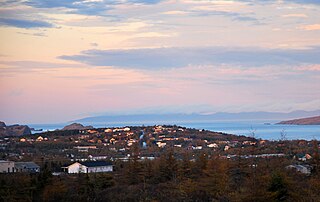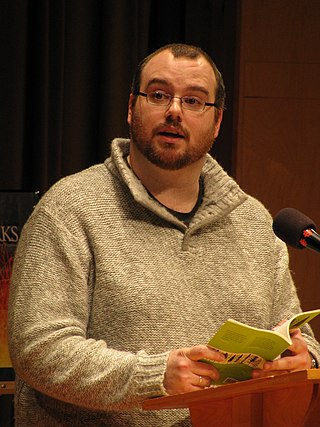
Newfoundland and Labrador is the easternmost province of Canada,in the country's Atlantic region. The province comprises the island of Newfoundland and the continental region of Labrador,having a total size of 405,212 km2 (156,453 sq mi). As of 2024 the population of Newfoundland and Labrador was estimated to be 545,247. The island of Newfoundland is home to around 94 per cent of the province's population,with more than half residing in the Avalon Peninsula. Labrador shares a land border with both the province of Quebec and the territory of Nunavut on Killiniq Island. The French overseas collectivity of Saint Pierre and Miquelon lies about 20 km (12 mi) west of the Burin Peninsula.

Carbonear is a town on the Avalon Peninsula in Newfoundland and Labrador,Canada. It overlooks the west side of Conception Bay and had a history long tied to fishing and shipbuilding. Since the late 20th century,its economy has changed to emphasize education,health care,retail,and industry. As of 2021,there were 4,696 people in the community.
The 1869 Newfoundland general election was held in 1869 to elect members of the 10th General Assembly of Newfoundland in the Newfoundland Colony. 21 Anti-Confederates (A-C) were elected against 9 Confederates (Con),ending for a moment the debate over joining the Dominion of Canada.

The Railway Coastal Museum is a transport museum located in St. John's,Newfoundland and Labrador,Canada. It is located in the historic Newfoundland Railway terminal on Water Street and contains exhibits detailing the history of the Newfoundland Railway and the history of coastal water transportation in the province.

Bay Roberts is a town located on the north shore of Conception Bay on the northeastern Avalon Peninsula in the province of Newfoundland and Labrador,Canada. The growth of the local economy can be connected to the town's proximity to other major Newfoundland markets,by road and by water.
Jerome Kennedy KC,,is a Canadian lawyer and politician in Newfoundland and Labrador,who served in the cabinets of Premier Kathy Dunderdale and Danny Williams.

The 1932 Newfoundland general election was held on 11 June 1932 to elect members of the 28th General Assembly of Newfoundland. This vote proved to be the final general election held by the Dominion of Newfoundland. As a result of a riot which occurred in 1932 due to Newfoundland's deteriorating economic situation,Prime Minister Sir Richard Squires dissolved the House of Assembly and called an election. His Liberals were reduced to two seats while Frederick C. Alderdice's United Newfoundland Party won 24 seats and was elected to government. The size of the House was reduced from 40 to 27 as an economy measure.

Stephen Rowe is a Canadian poet.
Thomas Talbot was an Irish-born educator and political figure in Newfoundland. He represented St. John's West in the Newfoundland and Labrador House of Assembly from 1861 to 1870 as a Liberal and then Anti-Confederate.

Walter Baine Grieve was a merchant and political figure in Newfoundland. He represented Bonavista Bay from 1882 to 1883 and Trinity Bay from 1885 to 1889 in the Newfoundland and Labrador House of Assembly.
The 1882 Newfoundland general election was held in 1882 to elect members of the 14th General Assembly of Newfoundland in the Newfoundland Colony. The Conservative Party led by William Vallance Whiteway formed the government.
Alfred Penney,Esq. was a merchant,judge and political figure in Newfoundland. He represented Bay de Verde in the Newfoundland and Labrador House of Assembly from 1878 to 1882 and Carbonear from 1882 to 1889.
The 1878 Newfoundland general election was held in 1878 to elect members of the 13th General Assembly of Newfoundland in Newfoundland Colony. The Conservative Party led by William Vallance Whiteway formed the government.

The 1913 Newfoundland general election was held on 30 October 1913 to elect members of the 23rd General Assembly of Newfoundland in the Dominion of Newfoundland. The Liberal Party led by Robert Bond formed a coalition with the Fishermen's Protective Union led by William Coaker. Although the majority held by the Newfoundland People's Party was reduced in this election,it was again returned to power and Edward P. Morris continued to serve as Prime Minister of Newfoundland. A general election originally scheduled for 1917 was deferred until 1919 because of World War I. After Morris retired from politics in 1918,William F. Lloyd,a Liberal member of the Executive Council,was asked to form a government. In May 1919,Michael Patrick Cashin,the leader of the People's Party,introduced a motion of no confidence which resulted in the defeat of the government. Cashin served as Newfoundland prime minister until the election held later in 1919.
John R. Goodison was a merchant and political figure in Newfoundland. He represented Carbonear in the Newfoundland and Labrador House of Assembly from 1909 to 1917 as a member of the Newfoundland People's Party.
George William Clarke was a lawyer and political figure in Newfoundland. He represented Carbonear in the Newfoundland and Labrador House of Assembly from 1956 to 1971.
Augustus Taylor Rowe was a Canadian physician and politician. He served as a member of the Newfoundland and Labrador House of Assembly for Carbonear from 1971 to 1975. He also spent three years as the province's Health Minister within the cabinet of the former Premier Frank Moores from January 1972 to 1975.

The members of the 14th General Assembly of Newfoundland were elected in the Newfoundland general election held in November 1882. The general assembly sat from 1883 to 1885.
John Edgar Pickavant Peters (1839–1919) was a businessman and politician in Newfoundland. He represented Burin in the Newfoundland House of Assembly from 1882 to 1885 as a member of the New Party and from 1885 to 1889 as a member of the Reform Party.
William Penman Saunders was a business manager and politician in Newfoundland. He represented Bay de Verde in the Newfoundland House of Assembly from 1962 to 1971.









